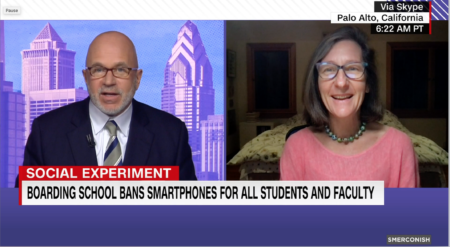How is TikTok Like Crack Cocaine? (Or What Is Your Smartphone Doing to Your Brain?)

Why is TikTok the equivalent of crack cocaine?
When you wake in the morning, is the first thing you do to reach for your phone?
What are smartphones and social media doing to our brains? Why do we feel so anxious without them?
In this fascinating Smerconish CNN interview with Dr. Anna Lembke, professor of psychiatry at Stanford University School of Medicine, she explains what dopamine has to do with our smartphones. She is the author of Dopamine Nation: Finding Balance in the Age of Indulgence.
The interview is engaging, easy to follow, and well worth a listen. It takes just 7 minutes to begin taking back your brain. Highlights from the conversation follow:
What is dopamine, and what does it have to do with smartphones?
- Dopamine is a feel-good chemical we make in the brain. “It is fundamental to the experience of pleasure, reward and motivation and also key to getting addicted.”
- “When we do something that is reinforcing like engaging in a behavior, we release dopamine in a specific part of the brain called the reward circuit. Devices are very rewarding, releasing a whole lot of dopamine in our brain circuitry.”
- The process of getting addicted to a drug is really the same as getting addicted to a device or social media. People start out using to have fun or solve a problem.
If dopamine makes you feel good, what’s the problem?
- When you first get a shot of dopamine, you feel wonderful. Social media apps and platforms are designed to give you a dopamine rush. The problem is that our bodies adjust to this high so that it no longer works, and we need to maintain it simply to feel normal.
- Over time, our brains will adapt to that increased surge of dopamine. It puts us in “a dopamine deficit state…akin to a clinical depression or to an anxiety disorder. So now, we’re using this substance not to feel good or get high but just to bring ourselves back up to baseline.”
- We lose a sense of time when we’re chasing dopamine. The first time Dr. Lembke tried TikTok, she was on it for three hours without noticing.
- When we’re not using, we experience the universal symptoms of withdrawal from any addictive substance: anxiety, irritability, insomnia, dysphoria, and craving (intrusive thoughts of wanting to use our drug).
Is there any hope? Can you break an addiction to your device?
- Yes, it is possible to break an addiction. It takes a fast. Thirty days is about the average time to restore normal dopamine firing. One young man addicted to video games tried it. The first two weeks, he went into withdrawal, experiencing the universal physiological symptoms. By week 3 and 4, he was feeling so much better, better than he had in years. He was able to reengage with the world and meaningful relationships in his life.
- It is also possible to use social media and smartphones without falling into addiction, letting them control you. Dr. Lembke uses “self-binding strategies” to limit her consumption. “Since quantity and frequency matter with addiction,” she explains, “placing barriers between ourselves and that drug of choice works.”
- For example, Dr. Lembke says she won’t touch a device until she’s made her bed, brushed her teeth, exercised, eaten breakfast, and so forth. She’ll make a list of what she needs to accomplish while on social media. Once she’s checked off her items, she’ll log off.
- With awareness and concerted effort, you can use your devices without their controlling you.
- She encourages listeners to start small. No screens for 24 hours. Do a fast. “Don’t touch a device and notice what you feel.”
Listen to the engaging 7-minute interview here at CNN.
Photo by Marjan Grabowski on Unsplash



